How to Retrieve Users Read/write Permissions in Linux Kernel
Privacy is an essential part of someone's life, whether social media or the workplace. Information technology helps protect the personal and professional person information that we don't want to share with everybody. Sometimes, people work on sensitive data that couldn't exist shared inside or outside the firm.
Similarly, when multiple users are connected with the system, they may demand some individual access to the specific resources. If we talk about files or folders/directories permission, information technology means you allow them to read, write, or change the files or directories. It is essential to revert the ownership of files/folders from the users who are not part of your current account but can ain them.
It is assumed as challenging for a Linux user to access permission to a file or folder because they are a flake aware of it. Setting the permission to the specific folder is quite uncomplicated and can exist done via control-line or GUI (nosotros will later hash out how we can practise it).
In that location are two levels in the Linux system for authorization that you must need to sympathise:
- Ownership
- Permission
Allow's explain both of them to empathize what categories they are further divided into:
Buying:
If we talk about buying of files or folders in the Linux operating arrangement, they are split into three types:
- User
- Group
- Others
The user-created the folder, and that's why sometimes we claimed information technology as an owner. Information technology is represented as "u" in the command line when giving admission through commands.
A group contains several Linux users connected to a system having the same permission access. It is helpful when many users apply the organisation and give them folder permission to access it. You can make a grouping to add all of them instead of assuasive them individually. In this example, people other than the group couldn't exist able to access the folder. The representative form of grouping members in the Linux command-line is "g."
The other category includes public users that are not role of group members or ownership. If you are permitting the others, we can say you are allowing everybody in the earth to access the files/folders. Sometimes, it could be dangerous, so think twice before doing it. The public users are represented by "o":
Go on in Mind:
u 🡪 user
thou 🡪 group
o 🡪 public
Permission:
At that place are 3 types of permission you can give to the owners we have mentioned below:
- Read
- Write
- Execute
In the read (r) mode, a user can open up a file/folder and read it, whereas the write (w) mode allows making changes in the file/folder. Yous take the authority to add content, remove or rename information technology.
Without executing (ten) permission, you can only read and write to the file, only you tin can't run it. To make the file executable, set the execute permission.
How to give the user permission to a binder in Linux:
Yous can give permission access to the user using a couple of approaches, via terminal and GUI.
Before directly jumping into it, note the specific commands to change permission and ownership.
- chmod command is used to modify permission
- chown command is used to modify ownership
How to give the user permission to a folder via command-line:
You lot tin can set permissions similar read, write, or execute the folder through the "chmod" control in a final.
Y'all can use the "chmod" command to modify permission settings in two dissimilar ways:
- Absolute Mode (numeric mode)
- Symbolic Mode
The difference between Absolute mode and symbolic mode is that in the Accented manner, yous can prepare permissions for all the owners (user, group, others) using the three-digit octal number instead of characters. Whereas in the symbolic mode, you can prepare permission through mathematical symbols and only for the specific owner.
Allow'southward demonstrate both of them:
Give user access to a folder through absolute fashion:
To understand how we tin can give permission admission to a folder through absolute manner, we demand to sympathize the given table in which numbers are mentioned for all the permission types.
| Numbers | Permission Types | Symbols for Permission |
| 0 | No Permission | — |
| 1 | Execute | –ten |
| 2 | Write | -westward- |
| iii | Execute + Write | -wx |
| 4 | Read | r– |
| 5 | Read + Execute | r-10 |
| half-dozen | Read + Write | rw- |
| 7 | Read + Write + Execute | Rwx |
Permit's run an instance to check how it is working:
To display the current permission settings of the folder "Testing_folder," run the post-obit command:

The output shows:
- Showtime rw– represents🡪 a user (possessor) who can read or write/edit the file only couldn't exist able to execute it since execute manner is fix to "-."
- The second rw– represents 🡪 a group (all the users added to the grouping) that can read or write/edit the file.
- The 3rd r— represents 🡪 others (public) who tin can only read the file
At present execute the chmod command to alter permission access:
$ chmod 760 Testing_folder

(760 🡪 owners can read, write or execute the file, the group can read and write, and there is no access for the public users)
Run the "ls" command to cheque the modification:
![]()
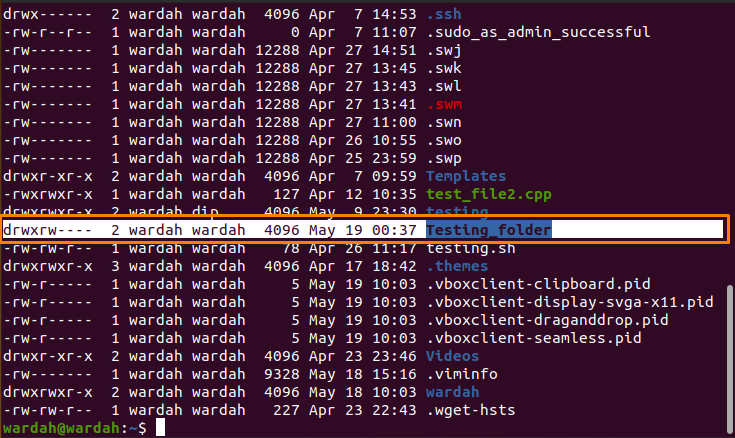
Give user access to a folder through symbolic mode:
3 operators are used in symbolic mode to gear up permission:
| Operator | Function |
| + | Add permission |
| – | Remove permission |
| = | Set the permission and override the previous permission settings |
Equally nosotros have mentioned in the introductory part that how to represents owners. So, allow'due south kickoff with an example:
Check the current permission setting of "Testing_folder" using the mentioned "ls" command:

To gear up permission to the user (owner), the command would be:
$ chmod u=rwx Testing_folder
–

Now, execute the "ls" command to get the output:
![]()

To remove read permission from the user, run the control:
$ chmod u-r Testing_folder

Now, execute the "ls" command to get results:
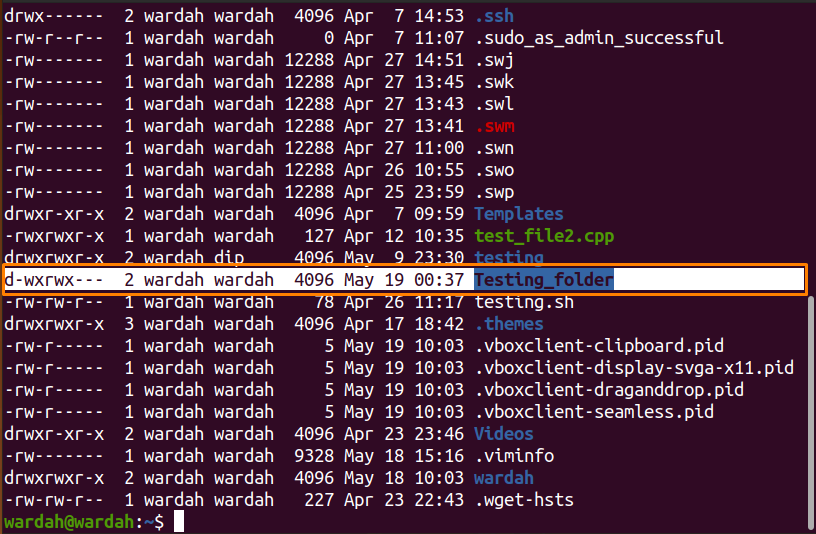
How to requite a user permission to a folder via GUI:
Changing the file permission using the GUI is the simplest arroyo. Follow the listed steps:
Open up the home directory, and navigate towards the targeted folder.
For example, to change the permission access to a folder "testing," firstly, select it:
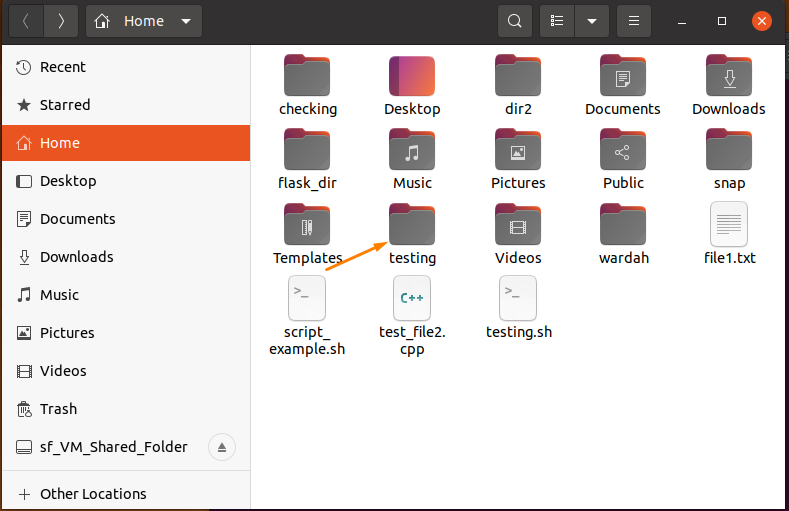
Right-click on the "testing" folder and select "Properties":
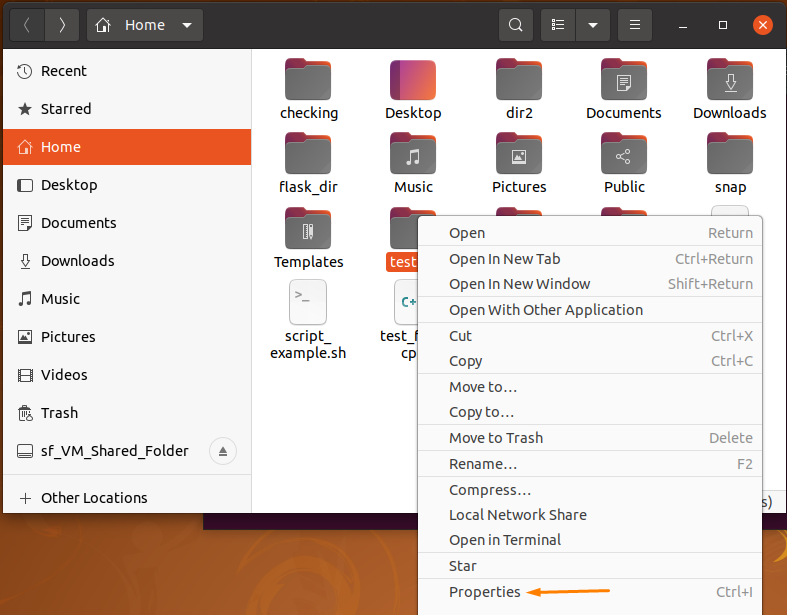
The "Properties" window will appear with iii tabs:
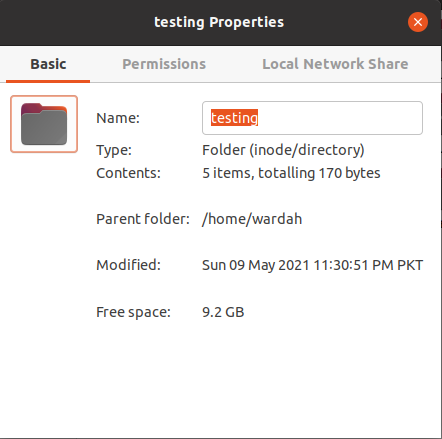
Navigate to the "Permissions" tab and select it:

From this tab, y'all tin make changes according to the requirement.
Click on the "Alter Permission for Enclosed Files," and you will get a window that allows the user to change the permission way, i-e read and write mode for the owners:
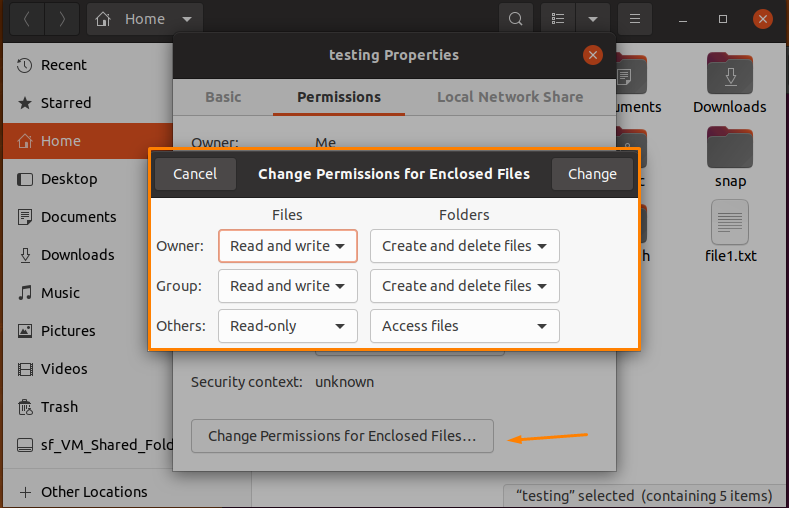
Suppose the current permissions condition of the "testing" folder is given below:

Allow'southward open the "alter permissions" window and modify the entries as:
Group 🡪 Read-just
Others 🡪 None
Navigate to the "change" button and click it.

Now, ostend using the "ls" control over again in the last if changes have been made successfully.

Conclusion:
Set permission access to the files or folders is compulsory nowadays for security reasons because someone who is no longer a office of your organization may too have folder access. To get control the security bug and go on the files rubber, you can fix permissions.
There are three categories of ownership i-e user, group, and others. And besides, nosotros have iii types for permission settings such equally read, write and execute.
You tin requite a user permission to the folder in two ways; via command-line and GUI. The GUI arroyo is better, in my opinion, every bit it is a pretty straightforward and elementary fashion to set permissions.
scratchleytoorepithe.blogspot.com
Source: https://linuxhint.com/give-user-folder-permission-linux/